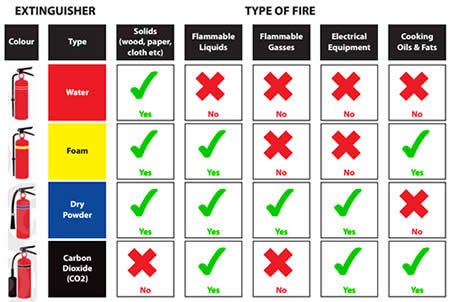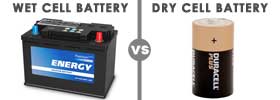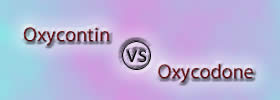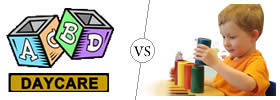Different Types of Fire Extinguishers
Key Difference: There are different types of fire extinguishers such as water based, powder based, CO2, Foam, Wet Chemical, etc. Extinguishers should be used depending on the type of fire.
 Not all fires are the same and similarly not all fire extinguishers are the same. Before one can grab a fire extinguisher and put out a fire, they must understand first what kind of fire it is and what kind of extinguisher is required for that fire. If the wrong extinguisher is used, instead of killing the fire, it can serve as fodder and increase the intensity of the fire.
Not all fires are the same and similarly not all fire extinguishers are the same. Before one can grab a fire extinguisher and put out a fire, they must understand first what kind of fire it is and what kind of extinguisher is required for that fire. If the wrong extinguisher is used, instead of killing the fire, it can serve as fodder and increase the intensity of the fire.
Depending on the place where one lives, the fire are often classified differently. In Australia, New Zealand, and United Kingdom, fires are often classified from A to F. However, in the United States, fire is classified using A, B, C, D, and K.
- Class A: ordinary combustibles such as wood, paper, fabric, and most kinds of trash.
- Class B/C: In the US system, all fires whose fuel is flammable or combustible liquid or gas is covered under the ‘B’ class. Under the Australian and European system, flammable liquids are designated "Class B", while burning gases are separately designated "Class C". These fires are caused by a flammable liquid such as gasoline, or gas such as natural gas.
- Class C/E: Under the US system, Class ‘C’ is designated to fires that involve potentially energized electrical equipment. Under the Australian system, this type of fire is classified as Class ‘E’. These fires are caused by short-circuiting of electrical equipment. In Europe, fires caused by electricity is not classified separately as it electricity itself cannot burn and classification happens based on the surrounding objects that burn.
- Class D: In all systems, combustible metals such as alkali metals (lithium and potassium), alkaline earth metals (magnesium), and group 4 elements (titanium and zirconium), are grouped under this Class.
- Class F/K: Any fires that involve unsaturated oils in well-insulated cooking appliances located in commercial kitchens. However, it is not limited to commercial kitchens, but also unsaturated oils in normal kitchens also fall under this area. In European and Australian classification, these fires are classified under ‘Class F’, while they are classified under ‘Class K’ in the American system.
 Understanding the different types of fire is usually a good way to understand which type of fire extinguisher one should use. It is essential to understand which extinguisher works, because ‘one size fits all’ approach may endanger lives. The extinguishers are often color coded to ensure people to identify which ones should be used where. The colors are Signal Red, Signal Red on a White Background, Blue, Cream, Black, and Canary Yellow.
Understanding the different types of fire is usually a good way to understand which type of fire extinguisher one should use. It is essential to understand which extinguisher works, because ‘one size fits all’ approach may endanger lives. The extinguishers are often color coded to ensure people to identify which ones should be used where. The colors are Signal Red, Signal Red on a White Background, Blue, Cream, Black, and Canary Yellow.
Water Extinguisher: This extinguisher includes nothing but water which is sprayed on to the fire. This is classified in Signal Red, which means it can be used on Class A such as wood, paper, fabric, and most kinds of trash. It works by cooling the surfaces and reduces spreading the fire to surrounding areas and to douse the fire.
Water Spray Extinguisher: These extinguishers come with an additive that helps douse the fire faster. This extinguisher also works on Class A fires and should not be used with any fires with electrical appliances or oil based fires.
Water Mist Extinguisher: This extinguisher comes with a red writing on a white label and is a dry water mist extinguisher which means it is something like water but not exactly like water. Hence, it works for all of the classes mentioned above, even the electrical fires as the mist is non-conducive. This is the most common type of extinguisher that can be found in almost all buildings.
Powder Extinguisher: This extinguisher works on Classes A, B, C and E. It contains a powder formula that acts as a thermal ballast reducing the temperature of the flames to ensure that it is too cool for the chemical reactions to continue. This extinguisher works well with fires involving organic solids, liquids such as grease, fats, oil, paint, petrol, etc. but not on chip or fat pan fires.
Dry Powder Extinguisher: While, the previous ones do not work on combustible materials and minerals, this extinguisher was designed to tackle fires involving combustible metals such as lithium, magnesium, sodium or aluminum when in the form of swarf or powder. The label has a blue sticker.
Foam Extinguisher: This extinguisher has a cream background and is designed to work on fires of Classes A, B, and C. The foam extinguishes fires involving solids and burning liquids, such as paint and petrol but not suitable for chip or fat pan fires. It can also work on Class C/E.
Carbon Dioxide Extinguisher: It has a black label with Carbon Dioxide that is written on it. This extinguisher works with Class C/E and douses fires started by electrical equipment. It is most commonly used in computer server rooms. Ensure that other people are out of the room when used as the CO2 can asphyxiate people present in the room.
Wet Chemical: This extinguisher is designed specifically to work on fires of Class F or fires that arise from cooking oils and fats. It comes with a potassium acetate that helps douse the fire and ensure that the fire does not exceed the pan. It comes with a canary yellow label.
Fire Blanket: These blankets are made of the same resistant material that the fireman suits are made of. It is used to douse fires by trying to put the fire out using the blanket to cover the fire. However, it was originally designed to cover people whose clothing is on fire. It can be used to put out fires that involve both solids and liquids.
Fire Buckets: These are similar to old fashioned fire buckets are can now be found in certain places where keeping access to fire extinguishers is hard. The bucket can be filled with sand or can be used to pour water on the fire. This bucket works best with Class A fire.
Image Courtesy: forsythfirerescue.org, ciaalarms.co.uk









Add new comment